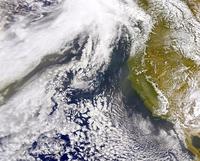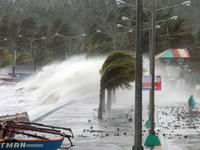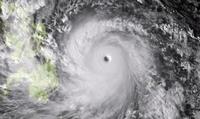-
China exports air pollution, as well as consumer goods, to the U.S.

Chinese air pollution blowing across the Pacific Ocean is often caused by the manufacturing of goods for export to the United States and Europe, according to findings of a new study. The study is the first to quantify how much of the pollution reaching the American West Coast is from the production in China of cellphones, televisions, and other consumer items imported here and elsewhere.
-
-
Coastal flooding in Ireland offers warning of things to come
Flooding in Ireland and the U.K. is typically associated with heavy rainfall, but the reason for more recent coastal flooding is different. Experts say that the increases in mean sea level suggests that mean sea-level rise rather than storminess is largely contributing to the dramatic increase in the frequency and scope of coastal flooding. Major cities like Cork, Dublin, and Galway will soon feel the impact of sea-level rise, and developers are discouraged from building within 100 meters of soft shoreline.
-
-
Tidal energy could provide half of Scotland’s power needs

A stretch of water off the north coast of the United Kingdom could provide enough energy to power about half of Scotland, engineers have found. Researchers have completed the most detailed study yet of how much tidal power could be generated by turbines placed in the Pentland Firth, between mainland Scotland and Orkney. They estimate 1.9 gigawatts (GW) could be available.
-
-
Growing threat of intense tropical cyclones hitting East Asia

The intensity of tropical cyclones hitting East Asia has significantly increased over the past thirty years, according to a new study. The coastlines of China, Korea, and Japan in particular have experienced increasingly stronger cyclones, which the researchers have attributed to increasing sea surface temperatures and a change in atmospheric circulation patterns over the coastal seas.
-
-
Carbon nanotube sponge helps in water clean-up
A carbon nanotube sponge capable of soaking up water contaminants, such as fertilizers, pesticides, and pharmaceuticals, more than three times more efficiently than previous efforts has been presented in a new study published today. The carbon nanotube (CNT) sponges, uniquely doped with sulphur, also demonstrated a high capacity to absorb oil, potentially opening up the possibility of using the material in industrial accidents and oil spill clean-ups.
-
-
Toxins-breathing bacteria to help industry, environment
Preliminary tests suggest that the bacteria could be used to remove these pollutants from the wastewater and protect the surrounding ecosystems. Buried deep in the mud along the banks of a remote salt lake near Yosemite National Park are colonies of bacteria with an unusual property: they breathe a toxic metal to survive. Researchers believe that this unusual organism may one day become a useful tool for industry and environmental protection – for example, the bacteria could be used simply to clean up the water, but it might also be possible for the bacteria to help humans recover and recycle the valuable elements in the water.
-
-
New L.A. fault map threatens Hollywood development projects
The state of California recently released new geological maps which reveal the presence of an active earthquake fault along the path of major developments in Hollywood. The maps established a zone of 500 feet on both sides of the fault, and state law will require new developments within the zone to conduct underground seismic testing to determine whether the fault runs beneath planned development sites. Building on top of faults is prohibited. Three prominent Hollywood developments — the Millennium Hollywood skyscraper project, the Blvd6200 development, and an apartment project on Yucca Street — are within the 500-foot fault zone.
-
-
Massachusetts takes steps to withstand climate change impacts
Governor Deval Patrick of Massachusetts earlier this week unveiled a $50 million plan to help prepare Massachusetts for the challenges climate change poses to energy supplies, public health, transportation, and basic infrastructure in his state. A $40 million grant from the state’s Department of Energy Resources will help cities and towns develop protections around energy services, and $10 million will go toward shoring up critical coastal infrastructure and dam repair.
-
-
The causes of recent Caribbean earthquakes
A 6.4-magnitude earthquake shook Puerto Rico Monday 13 January. It caused some power outages and cracked floors, but no major damage or injuries were reported. The quake, which struck the northern coastal town of Hatillo, is one of the largest to hit the U.S. territory in recent years. This event comes four days after a 5.0-magnitude earthquake rattled Havana, Cuba. Researchers say that the earthquake in Puerto Rico occurred on the North American-Caribbean plate boundary, whereas the earthquake in Cuba happened well inside the North American plate. Although inter-plate earthquakes do occur, often on older faults that are reactivated, they are less common than those that form at plate boundaries.
-
-
Stimulating plant growth and increasing crop yields
Plants naturally slow their growth or even stop growing altogether in response to adverse conditions, such as water shortage or high salt content in soil, in order to save energy. They do this by making proteins that repress the growth of the plant. Growth repression can be problematic for farmers as crops that suffer from restricted growth produce smaller yields. Scientists have discovered a natural mechanism in plants that could stimulate their growth even under stress and potentially lead to better crop yields.
-
-
Europe facing more severe and persistent droughts
Drought is a major natural disaster that can have considerable impacts on society, the environment, and the economy. In Europe alone, the cost of drought over the past three decades has amounted to over 100 billion euros. Europe has been battered by storms in the last few years, but researchers warn that many river basins, especially in southern parts of Europe, are likely to become more prone to periods of reduced water supply due to climate change. An increasing demand for water, following a growing population and intensive use of water for irrigation and industry, will result in even stronger reductions in river flow levels.
-
-
Geoengineering measures to cool the planet would cause climate chaos
Geoengineering — the intentional manipulation of the climate to counter the effect of global warming — is being proposed as a last-ditch way to deal with the problems of climate change. New research suggests geoengineering could cause massive changes to rainfall patterns around the equator, drying the tropical rainforests in South America and Asia, and intensifying periods of drought in Africa.
-
-
2013 natural catastrophes dominated by extreme weather in Europe, Supertyphoon Haiyan

Exceptionally high losses from weather-related catastrophes in Europe and Supertyphoon Haiyan dominated the overall picture of natural catastrophes in 2013. Floods and hailstorms caused double-digit billion-dollar losses in central Europe, and in the Philippines one of the strongest cyclones in history, Supertyphoon Haiyan, resulted in a human catastrophe with over 6,000 fatalities.
-
-
Abandoned mine offers clues about permanent CO2 sequestration
Power plants and other industries are responsible for more than 60 percent of global CO2 emissions, according to the International Energy Agency. Sequestering the CO2 in magnesite deposits would prevent the gas from entering the atmosphere and warming the planet. Stanford University researchers, studyingveins of pure magnesium carbonate, or magnesite — a chalky mineral made of carbon dioxide (CO2) and magnesium – in an abandoned mine in the Red Mountain, propose a novel technique for converting CO2 into solid magnesite, making CO2 sequestration feasible.
-
-
Narrow view of science deters 10-14 year old students from considering science careers
Careers in science rarely appeal to 10-14 year old students unless the student has a family connection to science, new research finds. Researchers, using more than 19,000 survey results and a series of longitudinal interviews at three intervals over five years with students and parents, conclude that students are turned off pursuing science by a narrow view of where studying science leads and lofty conceptions of who is capable of it.
-
- All
- Regional
- Water
- Biometrics
- Borders/Immig
- Business
- Cybersecurity
- Detection
- Disasters
- Government
- Infrastructure
- International
- Public health
- Public Safety
- Communication interoperabillity
- Emergency services
- Emergency medical services
- Fire
- First response
- IEDs
- Law Enforcement
- Law Enforcement Technology
- Military technology
- Nonlethal weapons
- Nuclear weapons
- Personal protection equipment
- Police
- Notification /alert systems
- Situational awareness
- Weapons systems
- Sci-Tech
- Sector Reports
- Surveillance
- Transportation
Advertising & Marketing: advertise@newswirepubs.com
Editorial: editor@newswirepubs.com
General: info@newswirepubs.com
2010-2011 © News Wire Publications, LLC News Wire Publications, LLC
220 Old Country Road | Suite 200 | Mineola | New York | 11501
Permissions and Policies
Editorial: editor@newswirepubs.com
General: info@newswirepubs.com
2010-2011 © News Wire Publications, LLC News Wire Publications, LLC
220 Old Country Road | Suite 200 | Mineola | New York | 11501
Permissions and Policies
